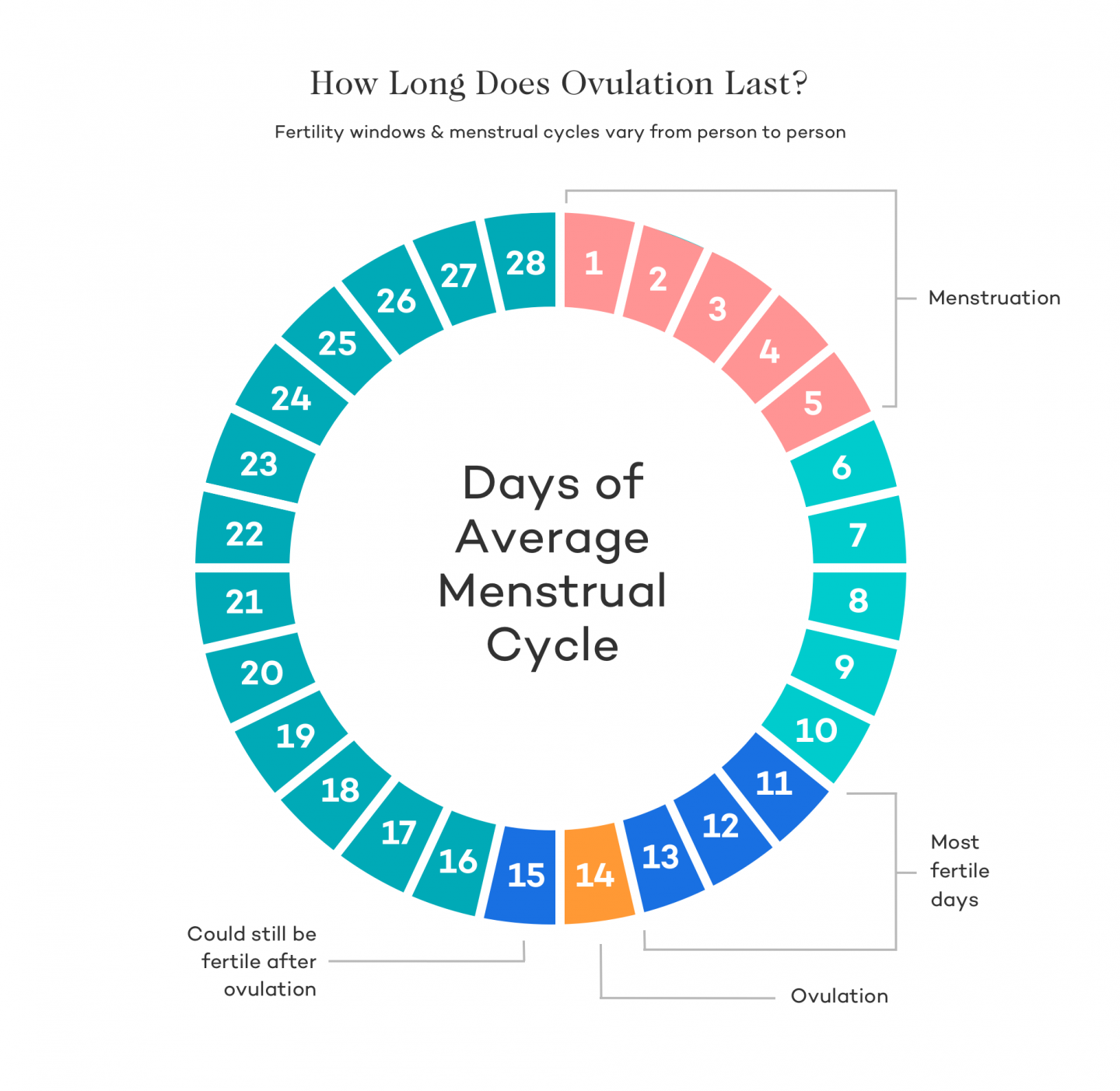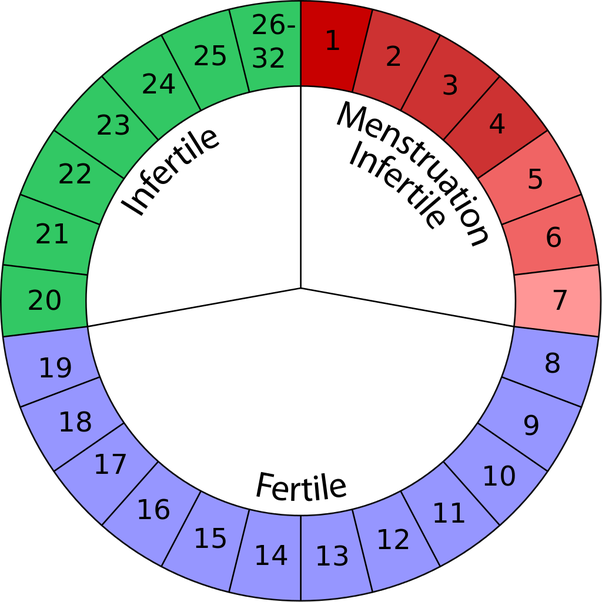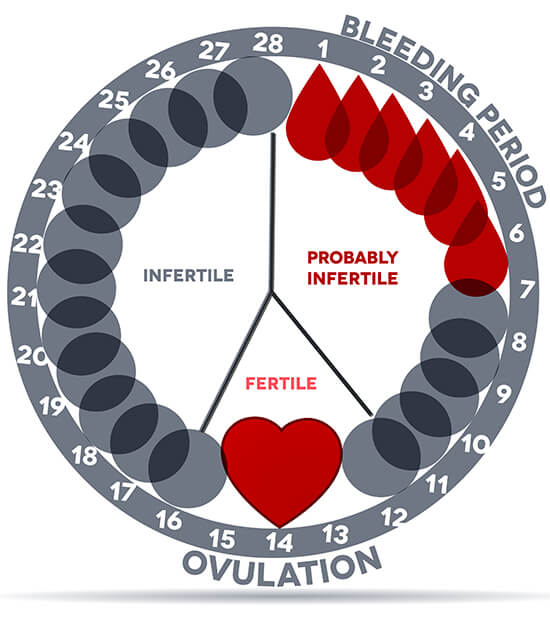How To Keep Track
You can use any type of calendar to track your menstrual cycle. You need to make sure whatever type of calendar you are using has enough space for you to make notes. You will be recording the days you have your period and any physical or emotional symptoms that you experience during your menstrual cycle. Remember, youll be sharing your menstrual cycle calendar with your healthcare provider.
You may prefer to use an app to track your menstrual cycle.
Its important to chart the days you menstruate and the amount of flow you have even if you have predictable periods that always start and end on time, and no symptoms to chart.
Other Ways To Find Your Most Fertile Days
There are other ways to identify when youre ovulating. Pay attention to your body and youll see signs that ovulation is imminent. Your cervical mucus changes as you approach ovulation. Right before your egg is released, youll notice a change in the mucus discharge in your vagina. It will be clear, slippery, and appear like the white of an egg. This indicates a highly optimal time to conceive.
Another way to determine when you are ovulating is by charting your basal body temperature using a basal thermometer. This method is not as reliable as the OPKs and therefore its use is usually not recommended any longer.
What If My Menstrual Cycle Is Way Different Than Average
There are lots of potential reasons for having an irregular period, and most of them are no big deal. Check out this article to find outâ¯more. If youâre worried, you can always tell a trusted adult or your doctor to help get to the bottom of why your period is irregular and what you can do about it.
Read Also: When Do You Know Your Period Is Coming
How Do I Test My Cervical Mucus
Watching the changes in the amount and consistency of your cervical mucus can help you understand your cycle. Heres how it works: check your secretions before and after urinating by wiping with toilet paper. Alternatively you can insert a clean finger into your vagina to obtain a sample of mucus. Observe the consistency of the mucus, and use this chart to identify where you are in your cycle. Your mucus can be cloudy, white, yellowish, or clear. It can have either a sticky or stretchy consistency. Use your thumb and forefinger to see if the mucus stretches.
| Cycle timing | |
| No noticeable mucus | Not fertile |
You are most fertile on the days when you have abundant, stretchy mucus. This is not a foolproof method to prevent pregnancy.
Can Weight Affect Menstrual Cycle Length

While aging is an inevitable thing that we all experience, other lifestyle factors may also impact the length of your menstrual cycle.
A previous study into the impact that physical exercise can have on hormone levels noted that losing fat can cause estrogen levels to drop, which can prevent ovulation and may cause irregularities in your period. In some cases, it may stop altogether.
Grieger and Norman were keen to do their own research here. So they used body mass index to identify any connections between weight and the menstrual cycles of Flo users. Your BMI is calculated by taking your weight in kilograms and dividing it by your height in meters squared.
In their study, Grieger and Norman found that BMI only has a small bearing on differences in peoples menstrual cycles. However, they did note that people with a higher BMI had an average cycle length of 36 days or more. People with a BMI of 18.524.9 were more likely to have a cycle of around 2135 days.
You may experience irregularities in your menstrual cycle, but Grieger and Norman concluded that BMI isnt likely to be the cause.
Recommended Reading: Does Birth Control Make Your Period Shorter
How To Calculate The Menstrual Cycle
Start with figuring out the days in your average cycle. To calculate your menstrual cycle, count the days between your last few periods. Begin counting on the first day of your period to the day before your next period.Do this for a few cycles, and add up the total number of days, dividing it by the number of cycles. That gives you the average number of days in your menstrual cycle.Besides this basic tracking, there are some other data points that you could consider that may help gauge irregularities and misses. Some of these include heavy flow, change in mood and energy levels, or a change in appetite. Keeping these details helps you closely monitor your health.
My Menstrual Cycle Is Still Irregular Has The Pill Affected My Fertility
Its unlikely the pill has caused any fertility problems, but it can sometimes cover up problems you already have, such as missing periods or PCOS .This is because the pill prevents the ovaries from releasing an egg , so although its normal to experience period-type bleeding on the pill, you dont have a real period.
Contact your GP if youre still having irregular periods 3 months after stopping contraception.
Also Check: When Should I Get My Period
Keep A Record Of Your Periods
Tracking your menstrual cycle simply means keeping a record of when youre menstruating and documenting other information related to your cycle. You used to have to do this with a calendar and pen, but now many great period-tracking apps make the job easy.
If you prefer to calculate your period the old-fashioned way, youll want to mark on a calendar the first day of bleeding with, for example, a slash or check mark, says , an obstetrician-gynecologist at the Cleveland Clinic in Ohio.
The length of your cycle is measured from that day to the first day of your next period, Dr. Attaran explains. For most women, the average cycle is 28 days, although anything from 21 to 35 days is considered normal in adult women.
RELATED: Is It Safe to Have Sex During Your Period?
What Causes Your Menstrual Cycle Length To Change: The Takeaway
Grieger and Norman set out to establish how lifestyle factors like stress levels, BMI, and smoking and alcohol habits could impact menstrual cycle length.
While Grieger and Norman concluded that age and stress levels may have a direct impact on changes to period and menstrual cycle length, their study concluded that BMI and alcohol and smoking habits had less of an effect.
Another thing to keep in mind is that although the average menstrual cycle is 28 days long, only 16 percent of participants in their study reported a cycle of this length. Anything between 21 and 35 days is considered normal, as are slight fluctuations each month.
Remember: You know whats normal for you, and you may notice that the length of your cycle changes as you get older, have children, or approach menopause. If youre at all concerned, speak to your health care professional.
References
Recommended Reading: How To Know If You Get Your First Period
How To Use Menstrual Period Calculator
It is quite simple 3 step process to calculate your next period and your menstrual cycle using MomJunction period calculator. Also, download customised menstrual calender for year.
- Enter the first day of your last menstrual period.
- Enter the average length of the menstrual cycle.
- Average duration of the last period.
Once you share all the above information,period calculator will share your following menstrual date for a year, fertility calendar, ovulation phase, fertile phase and estimated due date.
What Is The Luteal Phase
The luteal phase usually lasts 12-16 days. It is the time following ovulation until the next menstrual period. Following ovulation, the follicle that ruptured and released the egg closes and becomes a corpus luteum. The corpus luteum produces increasing levels of progesterone, preparing the endometrium for the implantation of a fertilized egg. If pregnancy does not occur, the corpus luteum breaks down and the levels of progesterone and estrogen decline. This results in the breakdown of the endometrium and menstrual bleeding occurs. If pregnancy does occur, the placenta begins to produce human chorionic gonadotropin . It is the top and middle endometrial layers that are shed during the menstrual period. The bottom layer remains, and prepares once again for implantation in the next cycle.
Read More:
Recommended Reading: How Many Pay Periods In 2021
Can Sperm Change Your Menstrual Cycle
After becoming sexually active, some people notice a change in their monthly cycle. Indeed, intercourse can trigger certain changes in the female body. Orgasms release large amounts of oxytocin. And even though you dont need to orgasm to become pregnant, it produces hormonal fluctuations and reduces stress.
What If My Cycle Is Irregular

It can be more difficult to get pregnant if you have irregular periods because you may not ovulate regularly.
There are many possible causes of irregular periods, which may affect your fertility. For example:
- medical conditions such as thyroid problems or polycystic ovary syndrome.
Having irregular periods does not mean you wont get pregnant and there are things you can do to boost your chances of success.
See your GP if your periods have stopped, youre missing monthly periods or you have irregular periods and are struggling to get pregnant.
Also Check: What Do Large Blood Clots During Period Mean
Comprehensive Explanation Of The Menstrual Cycle:
The menstrual cycle has three phases:
1. Follicular Phase
This phase of the menstrual cycle occurs from approximately day 1-14. Day 1 is the first day of bright red bleeding, and the end of this phase is marked by ovulation. While menstrual bleeding does happen in the early part of this phase, the ovaries are simultaneously preparing to ovulate again. The pituitary gland releases a hormone called FSH follicle stimulating hormone. This hormone causes several follicles to rise on the surface of the ovary. These fluid filled bumps each contain an egg. Eventually, one of these follicle becomes dominant and within it develops a single mature egg the other follicles shrink back. If more than one follicle reaches maturity, this can lead to twins or more. The maturing follicle produces the hormone estrogen, which increases over the follicular phase and peaks in the day or two prior to ovulation. The lining of the uterus becomes thicker and more enriched with blood in the second part of this phase , in response to increasing levels of estrogen. High levels of estrogen stimulate the production of gonadotropin-releasing hormone , which in turn stimulates the pituitary gland to secrete luteinizing hormone . On about day 12, surges in LH and FSH cause the egg to be released from the follicle. The surge in LH also causes a brief surge in testosterone, which increases sex drive, right at the most fertile time of the cycle.
2. Ovulatory Phase
3. Luteal Phase
How Do You Calculate Period Cycle
Familiarizing yourself with the four menstrual cycle phases can allow you to tweak your lifestyle habits including diet, exercise, and other activities to help you feel your best through every phase of your period cycle. Just dont treat your
How do you count a period cycle?
While Sonys PS4 and PS2 console families continue to hold higher sales counts, neither got to the 100 million mark as quickly as Switch, which only needed 57 months to do so . Enlarge / Nintendo Switchs 57 months to reach 100 million units sold, as compared to other members of the 100 million club.
Don’t Miss: Tips For When Your On Your Period
How Much Blood Is Lost During A Period
The amount of blood lost during a period will vary from woman to woman, but, on average, a woman will lose about 6 – 8 teaspoons of blood per period. A loss of 80 ml or more, having a period longer than 7 days, or both, is considered heavy. However, most women have a good idea of whether or not their bleeding is within the normal range for them.
What Is Toxic Shock Syndrome
Toxic shock syndrome is a rare but sometimes deadly condition caused by bacteria that make toxins or poisons. In 1980, 63 women died from TSS. A certain brand of super absorbency tampons was said to be the cause. These tampons were taken off the market.
Today, most cases of TSS are not caused by using tampons. But, you could be at risk for TSS if you use more absorbent tampons than you need for your bleeding or if you do not change your tampon often enough . Menstrual cups, cervical caps, sponges, or diaphragms may also increase your risk for TSS if they are left in place for too long . Remove sponges within 30 hours and cervical caps within 48 hours.9
If you have any symptoms of TSS, take out the tampon, menstrual cup, sponge, or diaphragm, and call 911 or go to the hospital right away.
Symptoms of TSS include:10
- Sudden high fever
Don’t Miss: How Do You Know You Are Getting Your First Period
How Do I Calculate When My Next Period Will Be
How Do Menstrual Cycle Calculators Work
Menstrual Cycle Calculators vary in complexity. Some will ask you for information such as your average body temperature, as well as various other bits and pieces about what your body is currently going through.
While there are women who measure their basal body temperature, its not something that the everyday woman uses.
However, it is a rather accurate way to determine when a woman is ovulating.
Some feel that these types of cycle calculators are overkill, but for those who are using the basal body temperature to prevent and plan a pregnancy, they have this information handy.
If you arent into this type of strict monitoring, a simple calculator like the one provided here can give you really good results and help you plan.
You May Like: Early Signs Of Pregnancy After Period
How Do You Count Your Period Cycle Days
The length of your cycle is the number of days between periods, counting the first day of your period until the day before your next period starts. For adults not using any form of hormonal contraception, a typical cycle length ranges between 24 to 38 days.
What Is A Menstrual Cycle

The menstrual cycle is different from a menstrual period. A menstrual cycle is the time period between the first day of a menstrual period or bleeding until the last day before the next menstrual bleeding. Having regular menstrual cycles is a sign that important parts of a person’s uterus and ovaries, especially ovulation are working normally. Regular menstrual cycles and regular menstrual bleeding usually indicate regular ovulation.
Do you know when you’re most likely to get pregnant each month? Test your fertility knowledge with our new quiz!
A menstrual cycle is counted from the first day of the menstrual bleeding or period to the first day of the next period. The average menstrual cycle is 28 days long, while menstrual bleeding usually lasts 3-5 days. Cycles can range anywhere from 21 to 35 days in adults and from 21 to 45 days in young teens.
The rise and fall of levels of hormones and ovulation during the month control the menstrual cycle.
Because menstruation is a function of regular ovulation, it begins in puberty and ends with menopause, when ovulation stops. The first day of bleeding is counted as the beginning of each menstrual cycle and the menstrual cycle ends on the day before the next menstrual period begins. Menstrual cycles normally range from about 21 to 35 days. Only about one in eight cycles are exactly 28 days.
Don’t Miss: What Could Cause A Late Period
When Are You Most Fertile
“Theoretically, there’s only a short time when women can get pregnant, and that is the time around ovulation,” says Belfield.
It’s difficult to pinpoint exactly when ovulation happens but in most women, it happens around 10 to 16 days before the next period.
“It’s not accurate to say that all women are fertile on day 14 of the menstrual cycle,” says Belfield. This might be true for women who have a regular, 28-day cycle, but it won’t apply to women whose cycles are shorter or longer.
For more information on fertility awareness, see the FPA guide to natural family planning.
Ovulation: Days 12 15
The pituitary gland releases a surge of luteinising hormone , triggering the release of the mature egg from the ovary and into the fallopian tube. Sperm can survive for up to 2 3 days in the fallopian tubes waiting for the arrival of the egg for fertilisation, however the egg has a window of approximately 12-24 hours in which it can be fertilised after release. The dominant follicle that has released the egg then forms the corpus luteum. This important structure releases progesterone which assist in maintaining the uterine lining.
Recommended Reading: Can You Ovulate On Your Period
What Is A Normal Menstrual Cycle
The menstrual cycle is a term used to describe the sequence of events that occur within your body as it prepares for the possibility of pregnancy each month. A menstrual cycle is considered to begin on the first day of a period. The average cycle is 28 days long however, a cycle can range in length from 21 days to about 35 days.
The steps in the menstrual cycle are triggered by the rise and fall of chemicals in your body called hormones. Your pituitary gland and your ovaries make and release certain hormones at certain times during your menstrual cycle that cause the organs of your reproductive tract to respond in certain ways. The specific events that occur during your menstrual cycle can be described as follows:
